The Spatiotemporal Evolution and Influencing Factors of the Ceramics Industry in Jingdezhen in the Last 40 Years
Abstract
1. Introduction
2. Study Area, Materials and Methods
2.1. Study Area
2.2. Materials
2.3. Methodology
2.3.1. Kernel Density Estimation
2.3.2. Exploratory Spatial Data Analysis
- (1)
- Global spatial autocorrelation analysis
- (2)
- Local spatial autocorrelation analysis
2.3.3. Geodetector
2.3.4. Selection and Calculation of Influencing Factors
3. Results
3.1. The Temporal Evolution of the Ceramics Industry
3.2. The Spatial Distribution of the Ceramics Industry
3.3. The Spatial Agglomeration of the Ceramics Industry
3.4. The influence of Factors on the Evolution of the Ceramics Industry
4. Discussion
5. Conclusions
Author Contributions
Funding
Data Availability Statement
Acknowledgments
Conflicts of Interest
References
- Li, W. Jingdezhen Taoci Shi: Modern and Contemporary; Jiangxi People’s Publishing House: Nanchang, China, 2016; pp. 2–3. [Google Scholar]
- Zhang, X.M.; Xie, H.L.; Zhou, C.H.; Zeng, B.D. Jingdezhen: The millennium porcelain capital. Cities 2020, 98, 102569. [Google Scholar] [CrossRef]
- Guo, J.; Li, H. Research on the Renaissance of International Ceramic Capital from the Perspective of Ceramic Cultural Industry. Jiangxi Soc. Sci. 2022, 4, 30–40. [Google Scholar]
- Robert, F. The Pilgrim Art: Cultures of Porcelain in World History; Hainan Publishing House: Haikou, China, 2022; p. 32. [Google Scholar]
- Hervas-Oliver, J.L.; Lleo, M.; Cervello, R. The dynamics of cluster entrepreneurship: Knowledge legacy from parents or agglomeration effects? The case of the Castellon ceramic tile district. Res. Policy 2017, 46, 73–92. [Google Scholar] [CrossRef]
- Scur, G.; Garcia, R. The impact of actors, networks and institutions in the cluster’s evolution: The case of the Brazilian ceramic tile industry. Compet. Rev. 2019, 29, 267–286. [Google Scholar] [CrossRef]
- Bellandi, M.; De Propris, L.; Santini, E. An Evolutionary Analysis of Industrial Districts: The Changing Multiplicity of Production Know-How Nuclei. Camb. J. Econ. 2019, 43, 187–204. [Google Scholar] [CrossRef]
- Tolliday, S.; Yonemitsu, Y. Microfirms and industrial districts in Japan: The dynamics of the Arita ceramic-ware industry in the twentieth century. J. Jpn. Stud. 2007, 33, 29–66. [Google Scholar] [CrossRef]
- Cusmano, L.; Morrison, A.; Pandolfo, E. Spin-off and clustering: A return to the Marshallian district. Camb. J. Econ. 2015, 39, 49–66. [Google Scholar] [CrossRef]
- Molina, B.D.; Molina, M.D.; Garrigos, J.A. The Innovative Regional Environment and the Dynamics of its Clusters. Eur. Plan. Stud. 2011, 19, 1713–1733. [Google Scholar] [CrossRef]
- Zhou, L.; Zou, X.; Huang, Y.; Li, Y.; Guo, L.; Fu, J. Inheritance and Innovation of Pottery Sculpture Technique in Shiwan, China: A Grounded Study from Cultural Ecology. Int. J. Environ. Res. Public Health 2023, 20, 3344. [Google Scholar] [CrossRef]
- Li, S. Study onspace-time succession mechanism of ceramic industry transfer baesd on the cluster theory: A Case Study of Chancheng District, Foshan City. Hum. Geogr. 2009, 01, 58–62. [Google Scholar]
- Liu, S. Research on Jingdezhen Ceramics Characteristic Industrial Cluster in the Changing Environment; Social Sciences Academic Press: Beijing, China, 2016; pp. 241–242. [Google Scholar]
- Xu, M.; Zuo, H. Behavioral mechanism, organizational environment and industrial cluster evolution: Take Jingdezhen ceramic industry as an example. Jiangxi Soc. Sci. 2013, 04, 59–63. [Google Scholar]
- Duan, L.; Du, D.; Huang, X. Spatial and temporal changes and influencing factors of the location of internet start-ups in Shanghai, China. Prog. Geogr. 2019, 3, 383–394. [Google Scholar] [CrossRef]
- Tomlinson, P.R.; Branston, J.R. Turning the tide: Prospects for an industrial renaissance in the North Staffordshire ceramics industrial district. Camb. J. Reg. Econ. Soc. 2014, 7, 489–507. [Google Scholar] [CrossRef]
- Lo, M.-h.; Han, D. China Ceramic Tile Industrial Cluster Competitive Strategies under the Global Economy. In Proceedings of the 2014 International Conference on Global Economy, Finance and Humanities Research (GEFHR 2014), Tianjing, China, 27–28 March 2014; pp. 120–123. [Google Scholar]
- Gabaldon-Estevan, D.; Criado, E.; Monfort, E. The green factor in European manufacturing: A case study of the Spanish ceramic tile industry. J. Clean. Prod. 2014, 70, 242–250. [Google Scholar] [CrossRef]
- Albors-Garrigos, J.; Hervas-Oliver, J.L. Disruptive Innovation in Traditional Clusters: The Case of the Kerajet Ceramic Tile Cluster in Spain. Appl. Sci. 2019, 9, 5513. [Google Scholar] [CrossRef]
- Segarra-Ona, M.D.; Peiro-Signes, A. Environmental Eco-orientation Determinants at the Spanish tile Industry. Dyna 2014, 89, 220–228. [Google Scholar] [CrossRef]
- Gabaldón-Estevan, D.; Fernández-de-Lucio., I. How does diversity affect district innovation systems? Findings from a comparative study of European ceramics. Trilogía Cienc. Tecnol. Soc. 2018, 10, 31–50. [Google Scholar] [CrossRef]
- De Souza, W.J.V.; Scur, G.; De Castro Hilsdorf, W. Eco-innovation practices in the brazilian ceramic tile industry: The case of the Santa Gertrudes and Criciuma clusters. J. Clean. Prod. 2018, 199, 1007–1019. [Google Scholar] [CrossRef]
- Wu, D.; Coe, N.M. Boundary spanners and the external market reach of clusters: The case of the Jingdezhen ceramics cluster in China. Reg. Stud. 2022, 57, 880–892. [Google Scholar] [CrossRef]
- Wu, D.; Coe, N.M. Bottom-up cluster branding through boundary spanners: The case of the Jingdezhen ceramics cluster in China. Urban Stud. 2023, 1–27. [Google Scholar] [CrossRef]
- Yang, X.; Xu, H.; Ni, S. The creative renewal of a craft cluster: The role of materiality and mobility in cluster evolution. Regional Studies 2021, 55, 546–555. [Google Scholar] [CrossRef]
- Wen, H.; Zeng, G. Development of the Cluster Embedding in the Global Value Chain: The study of the global ceramic tile cluster. China Ind. Econ. 2004, 6, 36–42. [Google Scholar]
- Zeng, G.; Wen, H. Study on global ceramic tile cluster embedded in the global value chain. China Econ. Geogr. 2005, 25, 467–470. [Google Scholar]
- Zuo, H.; Yang, J. Empirical Study on the Performance of Chinese Ceramic Industry Clusters Based on the Panel Data. China Ind. Econ. 2011, 9, 78–87. [Google Scholar]
- Wang, Y.; Liu, Y.; Cui, S.; Sun, B.; Gong, X.; Gao, F.; Wang, Z. Comparative life cycle assessment of different fuel scenarios and milling technologies for ceramic tile production: A case study in China. J. Clean. Prod. 2020, 273, 122846. [Google Scholar] [CrossRef]
- Zheng, L. A study on Chaozhou Ceramics industry’s space structure and forming mechanism. China Ceram. 2010, 46, 17–20. [Google Scholar]
- Yu, Z.; Li, X. Evolution Mechanism of Scale and Space of Traditional Technology Industry: Taking Jun Porcelain in Shenhou Town of Yuzhou City in Henan Province for Example. Areal Res. Dev. 2016, 35, 41–46. [Google Scholar]
- Li, S. The industrial regional transferring of China enterprise transference in Chancheng of Foshan. China Econ. Geogr. 2007, 27, 208–212. [Google Scholar]
- Guo, A.; Zhang, C. Jing De Zhen; Contemporary China Publishing House: Beijing, China, 2011. [Google Scholar]
- Commission, C.A.o.J.C. City Atlas of Jingdezhen; China Cartographic Publishing House: Beijing, China, 2020; p. 41. [Google Scholar]
- Wang, F. Quantitative Methods Applications in GIS; The Commercial Press: Beijing, China, 2009. [Google Scholar]
- Koutsias, N.; Balatsos, P.; Kalabokidis, K. Fire occurrence zones: Kernel density estimation of historical wildfire ignitions at the national level, Greece. J. Maps 2014, 10, 630–639. [Google Scholar] [CrossRef]
- Cui, N.; Feng, C.; Song, Y. Spatial pattern of residential land parcels and determinants of residential land price in Beijing. Acta Geogr. Sin. 2017, 72, 1049–1062. [Google Scholar] [CrossRef]
- Li, Q.; Yang, L.; Jiang, F.; Liu, Y.; Guo, C.; Han, S. Distribution Characteristics, Regional Differences and Spatial Convergence of the Water-Energy-Land-Food Nexus: A Case Study of China. Land 2022, 11, 1534. [Google Scholar] [CrossRef]
- Rey, S.J. Spatial Empirics for Economic Growth and Convergence. Geogr. Anal. 2010, 33, 195–214. [Google Scholar] [CrossRef]
- Luo, H.; Qu, X. Spatiotemporal Evolution Trends of Urban Total Factor Carbon Efficiency under the Dual-Carbon Background. Land 2023, 12, 69. [Google Scholar] [CrossRef]
- Wang, J.; Li, X.; Christakos, G.; Liao, Y.; Zhang, T.; Gu, X.; Zheng, X. Geographical Detectors-Based Health Risk Assessment and its Application in the Neural Tube Defects Study of the Heshun Region, China. Int. J. Geogr. Inf. Sci. 2010, 24, 107–127. [Google Scholar] [CrossRef]
- Wang, J.; Xu, C. Geodetector: Principle and prospective. Acta Geogr. Sin. 2017, 72, 116–134. [Google Scholar] [CrossRef]
- He, Q.; Yan, M.; Zheng, L.; Wang, B.; Zhou, J. The Effect of Urban Form on Urban Shrinkage-A Study of 293 Chinese Cities Using Geodetector. Land 2023, 12, 779. [Google Scholar] [CrossRef]
- Chen, Y.; Zhang, D. Jingdezhen Taoci Shi: Introduction to the History and Culture of Ceramics; Jiangxi People’s Publishing House: Nanchan, China, 2016; pp. 282–289. [Google Scholar]
- Fang, L. Tradition and Changes: Investigation into the History of Jingdezhen’s Folk Porcelains; Jiangxi People’s Publishing House: Nanchan, China, 2000. [Google Scholar]
- Zhu, H. Thoughts on accelerating the development of Jingdezhen ceramic industry. China Ceram. 2015, 51, 1–4. [Google Scholar]
- Zheng, S.; Xiong, X. Problems and countermeasures of resource accumulation area development of Jingdezhen ceramic industry. China Ceramics 2016, 52, 50–53. [Google Scholar]
- Lee, Y. Research on the Transformations of the Ceramics Manufacturing System in Jingdezhen-Focus on Recovery of the Handicrafts after 1950. J. Korean Soc. Ceram. Art 2015, 12, 189–204. [Google Scholar]
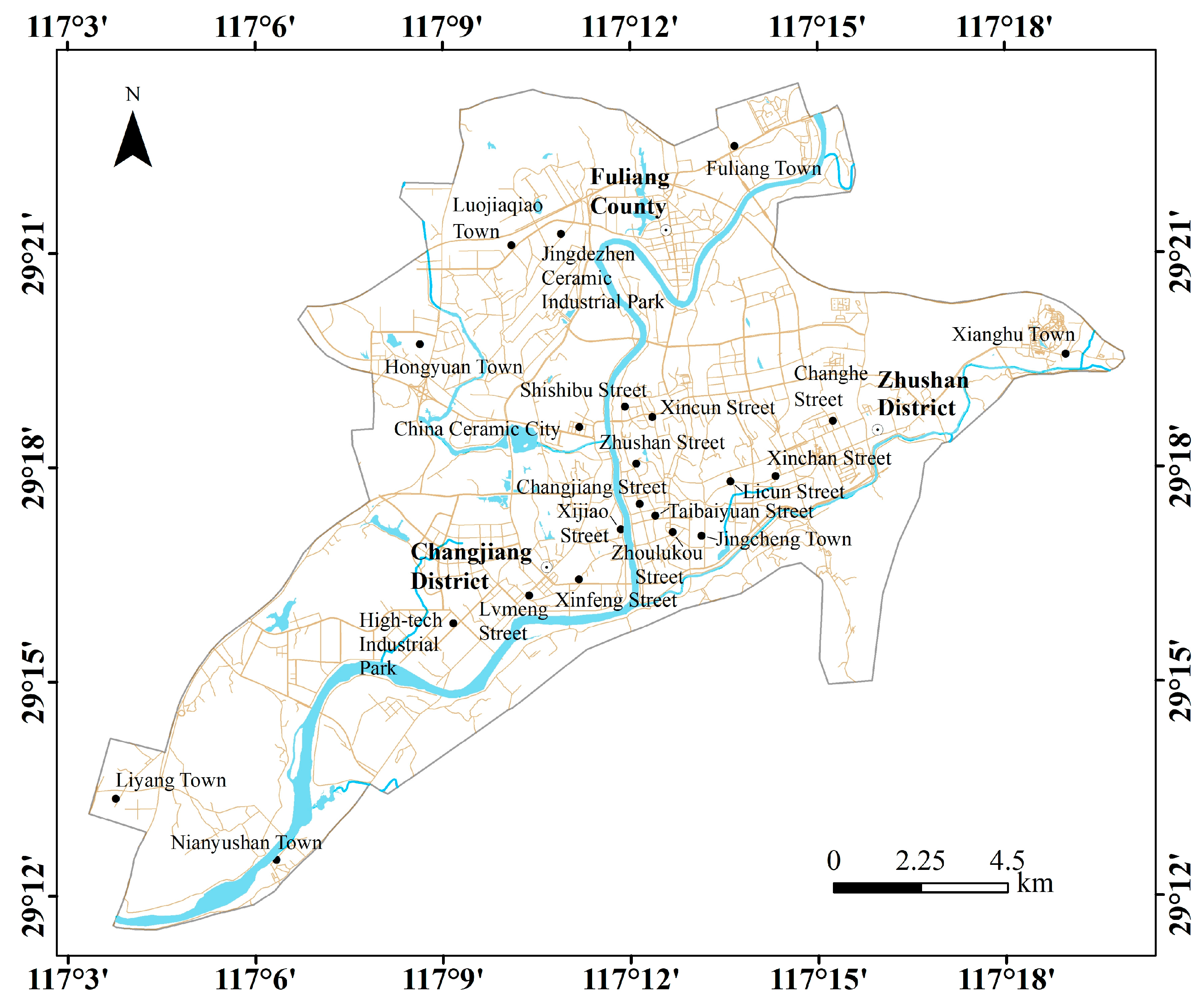
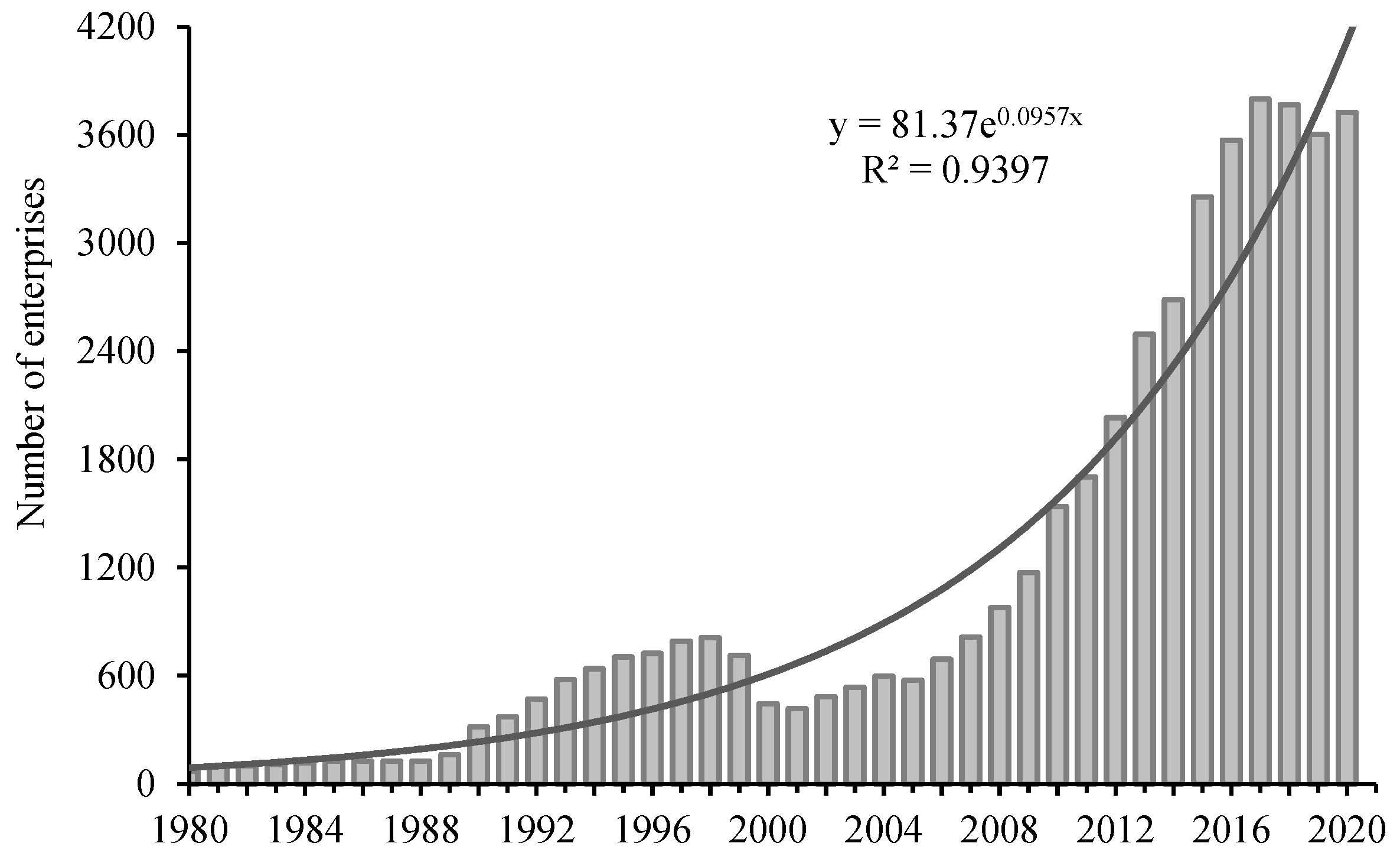
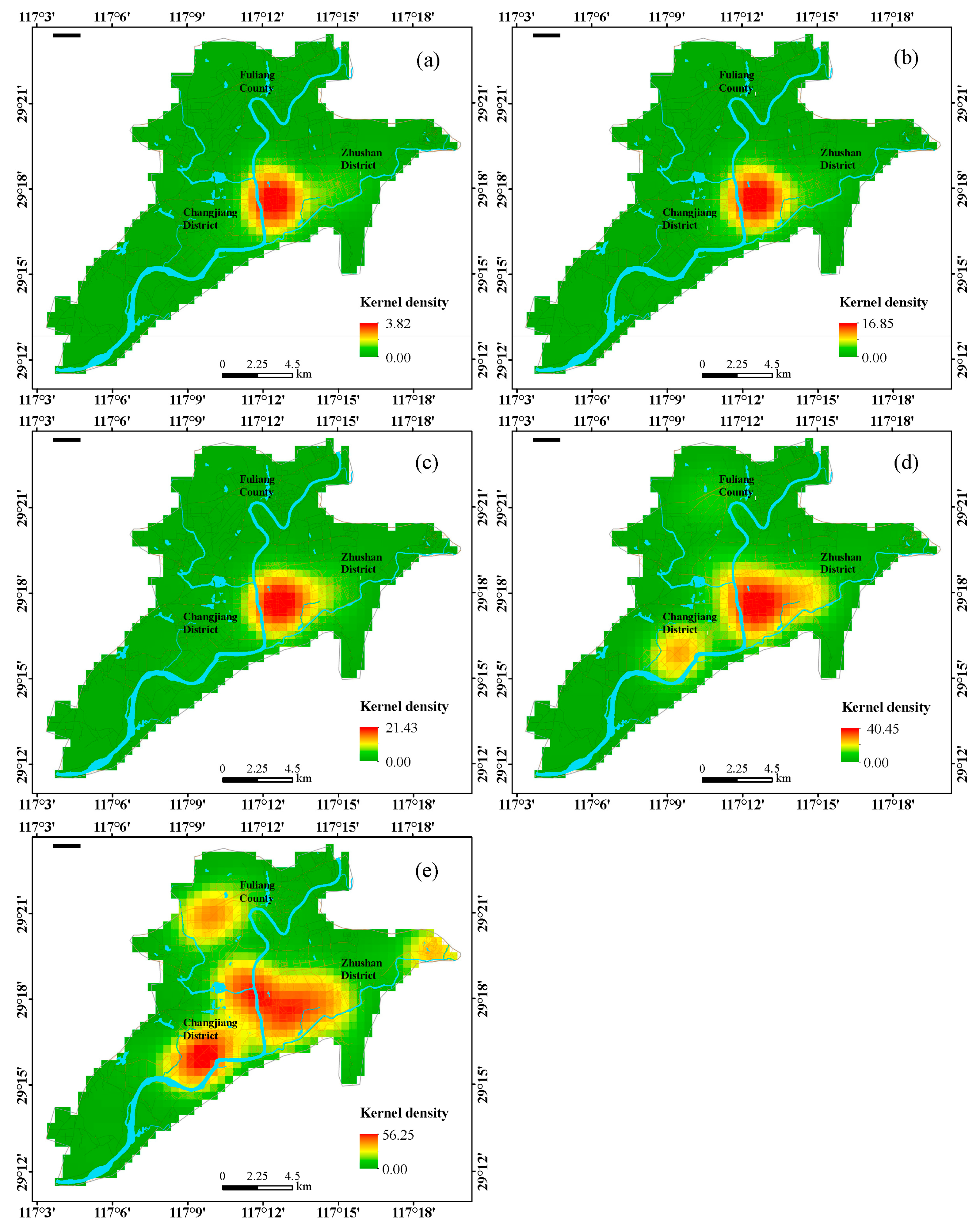
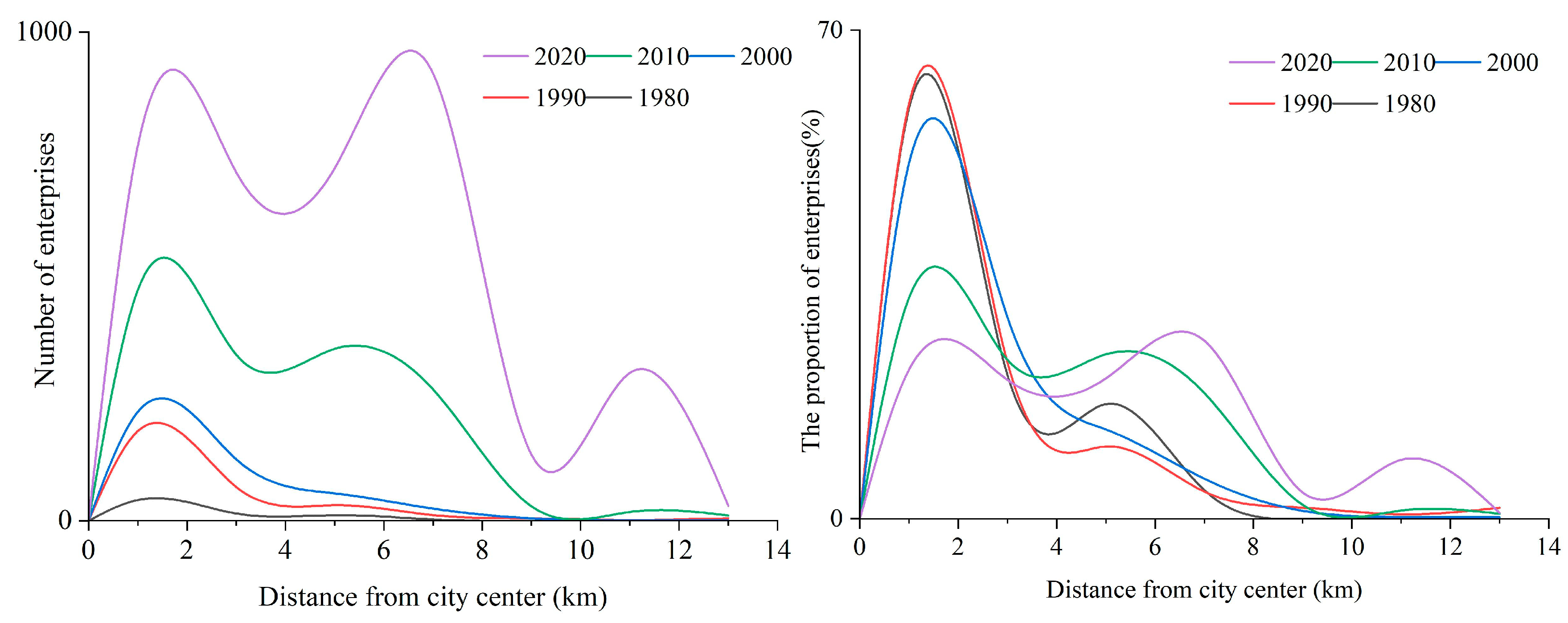
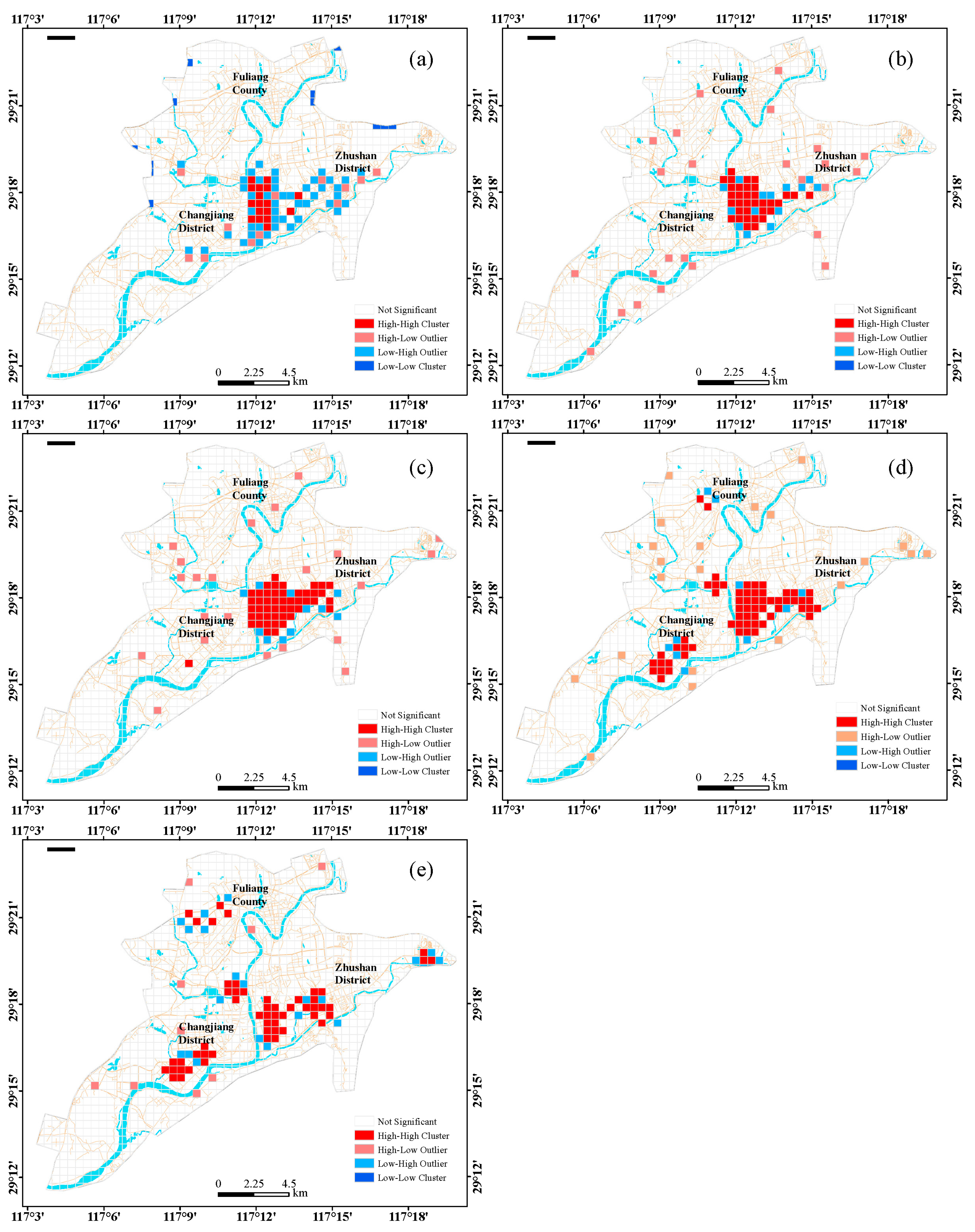
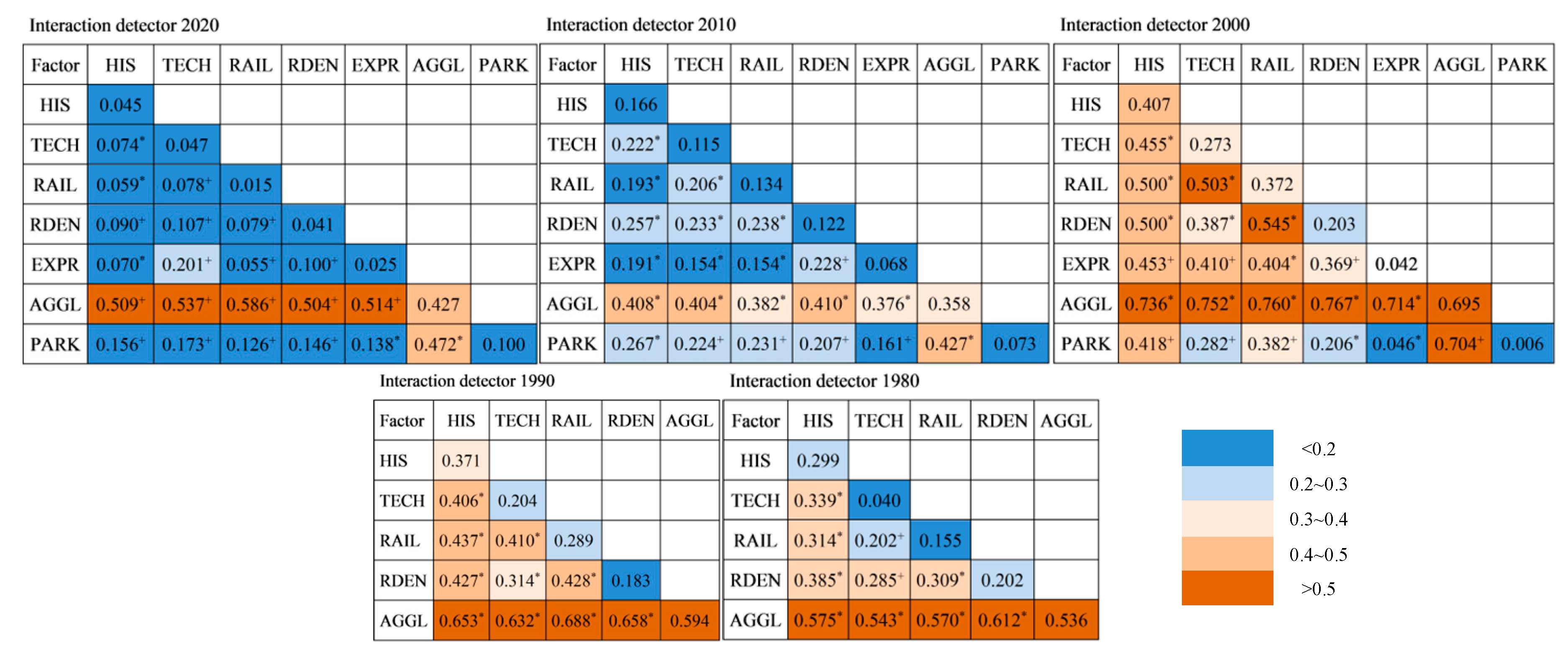
| Interaction Detection | Expressions | Meaning |
|---|---|---|
| Weaken, uni- | q(X1 ∩ X2) < min(q(X1), q(X2)) | Suggests that the nonlinearity weakens after the interaction between factors X1 and X2 |
| Weaken, nonlinear- | min(q(X1), q(X2)) < q(X1 ∩X2) < max(q(X1), q(X2)) | Means that the monoclinic line is weakened after the interaction of X1 and X2 |
| Enhanced, bi- | q(X1 ∩ X2) > max(q(X1), q(X2)) | Shows that X1 and X2 enhance each other after interaction |
| Enhanced, nonlinear- | q(X1 ∩ X2) > q(X1) + q(X2) | Shows that nonlinearity is strengthened after the interaction of X1 and X2 |
| Independent | q(X1 ∩ X2) = q(X1) + q(X2) | Shows that X1 and X2 are independent of each other |
| Classification | Variable | Meaning of Variables | Abbreviation of Variables |
|---|---|---|---|
| Historical Factors | Historical variable | The shortest distance to the “Ten Porcelain Factories” from the grid center | HIS |
| Technological Factors | Knowledge and technology variable | The shortest distance to ceramic research institutes and higher education institutions | TECH |
| Agglomeration Factors | Industrial agglomeration variable | The distribution of ceramic industry enterprises in the first 10 years in the grid | AGGL |
| Policy Factors | Park policy variable | The presence or absence of enterprises within the grid in the industrial park | PARK |
| Traffic Factors | Intra-city road density | Density of roads in the grid | RDEN |
| Distance to train station | Distance to the nearest railway station from the grid center | RAIL | |
| Distance to expressway entrance | Distance to the nearest expressway entrance from the grid center | EXPR |
| Parameters | 1980 | 1990 | 2000 | 2010 | 2020 |
|---|---|---|---|---|---|
| I-value | 0.371 | 0.604 | 0.629 | 0.366 | 0.233 |
| Z-value | 18.543 | 30.669 | 31.071 | 18.408 | 12.555 |
| p-value | 0.001 | 0.001 | 0.001 | 0.001 | 0.001 |
| Influencing Factor | 1980 | 1990 | 2000 | 2010 | 2020 |
|---|---|---|---|---|---|
| HIS | 0.299 ** | 0.371 ** | 0.407 ** | 0.166 ** | 0.045 ** |
| TECH | 0.040 ** | 0.204 ** | 0.273 ** | 0.115 ** | 0.047 ** |
| AGGL | 0.536 ** | 0.594 ** | 0.695 ** | 0.358 ** | 0.427 ** |
| RAIL | 0.155 ** | 0.289 ** | 0.372 ** | 0.134 ** | 0.015 ** |
| RDEN | 0.202 ** | 0.183 ** | 0.203 ** | 0.122 ** | 0.041 ** |
| EXPR | -- | -- | 0.042 ** | 0.068 ** | 0.025 ** |
| PARK | -- | -- | 0.006 | 0.073 ** | 0.100 ** |
Disclaimer/Publisher’s Note: The statements, opinions and data contained in all publications are solely those of the individual author(s) and contributor(s) and not of MDPI and/or the editor(s). MDPI and/or the editor(s) disclaim responsibility for any injury to people or property resulting from any ideas, methods, instructions or products referred to in the content. |
© 2023 by the authors. Licensee MDPI, Basel, Switzerland. This article is an open access article distributed under the terms and conditions of the Creative Commons Attribution (CC BY) license (https://creativecommons.org/licenses/by/4.0/).
Share and Cite
He, Q.; Zheng, X.; Xiao, X.; Luo, L.; Lin, H.; He, S. The Spatiotemporal Evolution and Influencing Factors of the Ceramics Industry in Jingdezhen in the Last 40 Years. Land 2023, 12, 1554. https://doi.org/10.3390/land12081554
He Q, Zheng X, Xiao X, Luo L, Lin H, He S. The Spatiotemporal Evolution and Influencing Factors of the Ceramics Industry in Jingdezhen in the Last 40 Years. Land. 2023; 12(8):1554. https://doi.org/10.3390/land12081554
Chicago/Turabian StyleHe, Qinghua, Xin Zheng, Xin Xiao, Lei Luo, Hui Lin, and Shan He. 2023. "The Spatiotemporal Evolution and Influencing Factors of the Ceramics Industry in Jingdezhen in the Last 40 Years" Land 12, no. 8: 1554. https://doi.org/10.3390/land12081554
APA StyleHe, Q., Zheng, X., Xiao, X., Luo, L., Lin, H., & He, S. (2023). The Spatiotemporal Evolution and Influencing Factors of the Ceramics Industry in Jingdezhen in the Last 40 Years. Land, 12(8), 1554. https://doi.org/10.3390/land12081554






